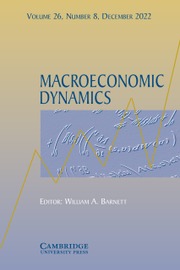No CrossRef data available.
Article contents
Understanding the gains from wage flexibility in a currency union: a fiscal policy connection
Published online by Cambridge University Press: 19 December 2024
Abstract
We investigate two findings in Gali and Monacelli (2016, American Economic Review): (i) the effectiveness of labor cost adjustments on employment is much smaller in a currency union and (ii) an increase in wage flexibility often reduces welfare, more likely in an economy that is part of a currency union. First, we introduce a distorted steady state into Gali and Monacelli’s small open economy model, in which employment subsidies making the steady state efficient are not available, and replicate their two findings. Second, an endogenous fiscal policy rule similar to that in Bohn (1998, Quarterly Journal of Economics) is introduced with a government budget constraint in the model. The results suggest that while Gali and Monacelli’s first finding is still applicable, their second finding is not necessarily valid. Therefore, an increase in wage flexibility may reduce welfare loss in an economy that is part of a currency union as long as wage rigidity is sufficiently high. Thus, there is scope to discuss how wage flexibility benefits currency unions.
Keywords
Information
- Type
- Articles
- Information
- Copyright
- © The Author(s), 2024. Published by Cambridge University Press
Footnotes
We have benefited from the comments made by Masataka Eguchi, Hideaki Murase, participants of the seminar and conference at Nagoya City University, Studio Europae Maastricht, and Chambre de Commerce et d’Industrie de Paris CCIP (the venue of the 7th International Workshop on “Financial Markets and Nonlinear Dynamics”). We also thank Fredj Jawadi (the guest editor of this special issue) and the anonymous referees for their helpful comments, as well as JSPS KAKENHI (Grant #19K01722) for their financial support. In addition, we appreciate the 7th FMND Workshop that produces this special issue. All errors are the authors’ responsibility.

